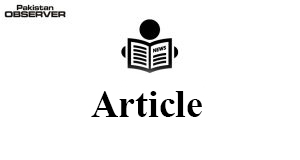Sohail Ahmed Soomro
OVER the years, new forms of security threats are increasingly warring against the modern nation states. Although, globe is facing unprecedented security threats, those are of non-traditional nature; be it terrorism, drug trafficking, serious communicable diseases, piracy, illegal immigration, environmental security, economic and financial security and information security. However, water crisis is one of the most important among them and this form of threat is conspicuous, especially among the developing states like ours. Undeniably, water is basic necessity of life. Adequate supply of water is necessary for food security specifically in agrarian economy like Pakistan. Therefore, it is need of time to plan water resources coupled with pragmatic approach. Although, available statistics of water availability has compelled poor economies to produce struggling response and however international strategists are of the view that future wars are likely to be waged on securing water resources most probably between Pakistan and India. Recently, IMF released its yearly report on water in 2019 which has alarmed the country about apathetic status of water resources. Report has pushed country on the verge of water-stressed threshold nearly 1017 cubic meter per capita against the threshold of 1000 cubic meter per capita. Moreover, it has become the world’s 23rd water-stressed country additionally it is on the way to become the most water-stressed country in the region. Thus it pushes country in struggling condition to respond on an emergency basis that has put nation on the serious concern.
Although, this issue of water crisis is not new one, however, it has been acquiring worsening position with every passing day. Nevertheless, ignorance from the policy makers’ part has added insult to the injury. Since Pakistan is the country with the exponential population growth and rapid urbanization specifically metropolitan cities like Karachi, Lahore etc. According to available statistics, former city has urbanized significantly up to 60 pc and latter one by 116 pc respectively between last two consecutive censuses. Therefore, such rise would definitely have far-reaching consequences for the available water resources. Therefore, stagnant water resources has proved to be insufficient in meeting the ever-growing population demand therefore it was need of hour to attach additional water reservoirs on the card. However, long-term policy-making in the history of Pakistan has never been attached much importance while short-term policy making has been primary source of increasing vote bank. Similarly, Pakistan is far-lagging behind in science and technology; where developed countries are working on the principle of zero water loss, on the other hand, Pakistan is using outdated methods of irrigation like Flooding, Basin etc. Therefore, sizable portion of water, relatively 93 pc, is eaten up by agriculture, in spite of dedicating such a massive portion, agricultural yield is still low and quality of crops produced are yet poor and the sector is predominantly untaxed. Similarly, water supplied for this purpose is largely cheap that pay back only fraction of revenue to national exchequer of what invested for annual operation and maintenance of irrigational infrastructure.
According to Pakistan Council of Research in Water Resources (PCRWR), 60pc of costly water is lost during the application and conveyance in the field. Thus use of efficient irrigation methods like Drip and Sprinkler is a need of time to save water. Although, UNDP (United Nation Development Program) conducted research on district Okara in which development of laser levelling and furrow-bed irrigation resulted into 30pc saving in water and led to 25pc increase in productivity. Furthermore, water carrying structures like canals and other water-courses should be maintained effectively and river training works should be executed pragmatically although canal patches with major water losses are highly imperative to be lined.Undeniably, construction of dams is the most feasible option for country to meet ever growing water crisis. Thanks to former CJP for his untiring efforts towards furthering the cause of dam construction process otherwise it would have been delayed for years to come, but probably relying on these two dams would not be enough to bear the burden of rampant population growth and climate change, as previously constructed dams are also giving up their capacity owing to siltation. For instance, Tarbela Dam capacity has reduced by more than 40 pc. Therefore, planning more dams in near future is essential for holding back looming water crisis. Pakistan gets around 145 million acre feet (MAF) of water annually, but it has hardly capacity to store 13.7 MAF however country needs more than 40 MAF of water thus whatever we store is far less than what is drained into sea.
Apart from water storage concern, water wastage is one of the major concerns, according to available statistics Pakistan wastes water worth 25 billion rupees every year. In contrast, water discharged into the Arabian Sea each year actually worth more than 20 billion dollars. This figure beyond any realm of doubt is excessively high especially for country (Pakistan) with precariously low water-storage capacity. IRSA statistics declares that Pakistan has merely 30 days water storage capacity against its counterpart India with 320 days. Nevertheless, gravity of problem is very serious thus modern problems require modern solution considering this fact water management should be made effective by overhauling existing irrigation infrastructure and building more dams on the rivers besides keeping national integrity on the main stake. However, making use of advanced agricultural farming in addition to modern irrigation methods is imperative for keeping water crises at the bays.
—The writer is research scholar at Water Resources Management MUET Jamshoro.










